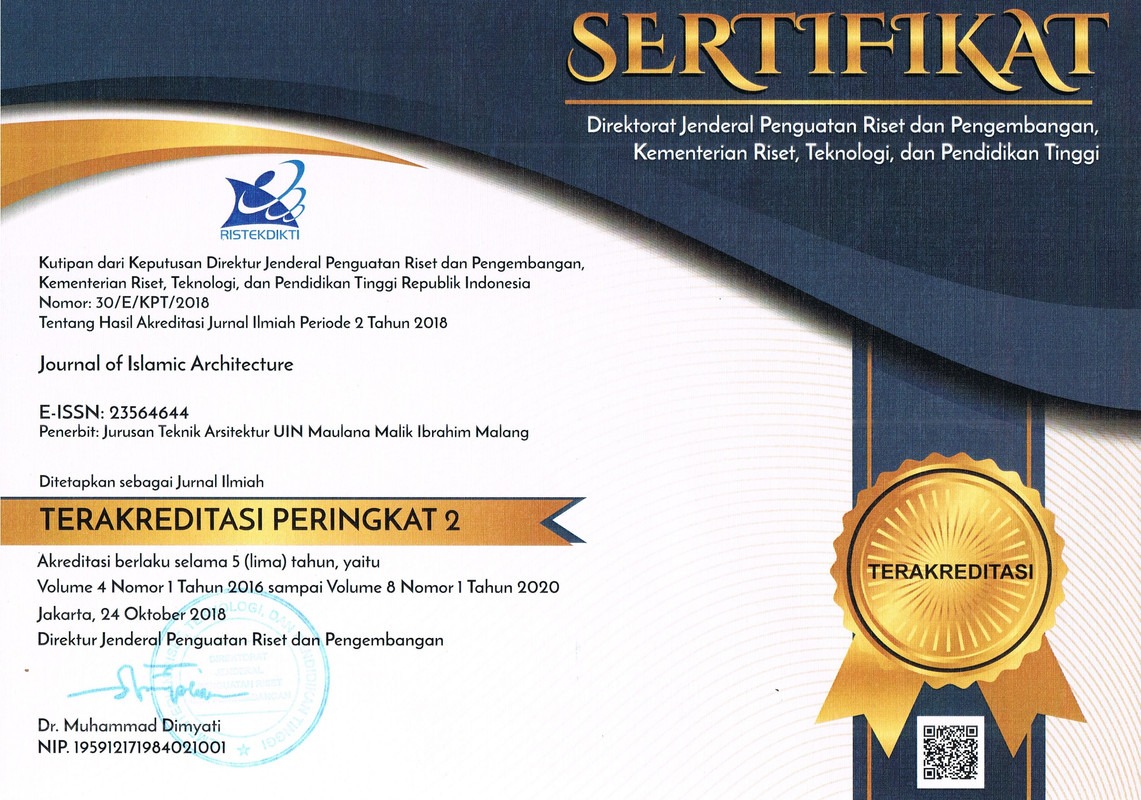RETHINKING HEIDEGGER'S DWELLING THROUGH ARABIC LINGUISTICS
Abstract
Inhabiting a space or dwelling has been a debatable terminology in architectural theory & practice. Martin Heidegger's conference paper "Building dwelling thinking" is a major philosophical work that influenced architects in the 20th century. The philosopher interpreted the word as an etymological archaeologist, working on the word's essential meaning until he related it to, Being-in-this-world and Being-towards-death. In this research, we examine the term "dwelling" through the Arabic parables "Maskan" and "Manzel" to reach a more comprehensive understanding that will unveil its essential meaning in its local cultural context. Moreover, we base our research on a survey answered in Lebanon, on the meaning of the word Maskan in its contemporary form, while linking it to Heidegger's etymological findings. Our results explicitly an Arabic term used that describes a different phenomenon in other cultures.
Keywords
Full Text:
PDFReferences
P. Cloke and J. Owain, “Dwelling, place, and landscape: an orchard in Somerset,” Environment and planning A, vol. 33, no. 4, pp. 649–666, 2001.
M. Heidegger, “Poetically Man Dwells,” Canadian Journal of Psychoanalysis, vol. 10, no. 2, pp. 233–236, 2002.
R. Chia and R. Holt, “Strategy as Practical Coping: A Heideggerian Perspective,” Organization studies, vol. 27, no. 5, pp. 635–655, 2006.
M. Davidson, “Displacement, Space and Dwelling: Placing Gentrification Debate,” Ethics Place and Environment (Ethics, Place & Environment (Merged with Philosophy and Geography)), vol. 12, no. 2, pp. 219–234, 2009.
D. Ladkin, “When deontology and utilitarianism aren’t enough: How Heidegger’s notion of ‘dwelling’ might help organisational leaders resolve ethical issues,” Journal of Business Ethics, vol. 65, no. 1, pp. 87–98, 2006.
D. Seamon, “Concretizing heidegger’s notion of dwelling: The contributions of thomas thiis-evensen and christopher alexander,” Building and dwelling [Bauen und wohnen], pp. 189–202, 2000.
C. Norberg-Schulz, “Heidegger’s thinking on architecture,” Perspecta, vol. 20, pp. 61–68, 1983.
A. Sharr, Heidegger for Architects. London: Taylor & Francis, 2007.
M. Heidegger, “Building Dwelling Thinking,” Poetry, Language, Thought, vol. 154, 1971.
J. Holst, “Rethinking Dwelling and Building,” ZARCH: Journal of Interdisplinary Studies in Architecture and Urbanism, vol. 2, pp. 52–61, 2014.
J. W. Alvis, “Making sense of Heidegger’s ‘phenomenology of the inconspicuous’ or inapparent (Phänomenologie des Unscheinbaren),” Continental Philosophy Review, vol. 51, no. 2, pp. 211–238, 2018.
T. D. Okoro, Modernity and Destining of Technological Being. Peter Lang Publishing Group, 2016.
O. Karamercan, “Heidegger’s Topology of Language: Language and Dwelling,” University of Tasmania, 2018.
M. El Moussaoui, “Phenomenology in Pure Aesthetics,” Journal of Civil Engineering and Architecture, vol. 14, pp. 168–173, 2020.
J. Malpas, Heidegger and the Thinking of Place: Explorations in the Topology of Being. Cambridge: MIT Press, 2012.
H. Martin, Being and Time. New York: Harper and Row, 1962.
Mujamaā al-Lugha Al Arabia b āl Kahera 5th Edition. Al Muājam Al wasit, 1960.
M. A. . A. Haleem, The Qur’an. Oxford: Oxford University press, 2005.
B. Gaston, The Poetics of Space. Boston: Beacon Press, 1958.
D. O. Dahlstrom, The Heidegger Dictionary. London: A&C Black, 2013.
DOI: https://doi.org/10.18860/jia.v6i2.8454
Refbacks
- There are currently no refbacks.






